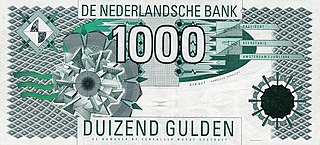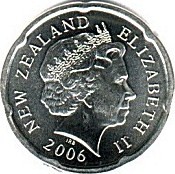Related Research Articles

The shilling is a historical coin, and the name of a unit of modern currencies formerly used in the United Kingdom, Australia, New Zealand, other British Commonwealth countries and Ireland, where they were generally equivalent to 12 pence or one-twentieth of a pound before being phased out during the 1960s and 1970s.

The Australian dollar is the official currency and legal tender of Australia, including all of its external territories, and three independent sovereign Pacific Island states: Kiribati, Nauru, and Tuvalu. As of 2022, it is the sixth most-traded currency in the foreign exchange market and also the seventh most-held reserve currency in global reserves.

A penny is a coin or a unit of currency in various countries. Borrowed from the Carolingian denarius, it is usually the smallest denomination within a currency system. Presently, it is the formal name of the British penny (abbr. p) and the de facto name of the American one-cent coin (abbr. ¢) as well as the informal Irish designation of the 1 cent euro coin (abbr. c). Due to inflation, pennies have lost virtually all their purchasing power and are often viewed as an expensive burden to merchants, banks, government mints and the public in general.

The New Zealand dollar is the official currency and legal tender of New Zealand, the Cook Islands, Niue, the Ross Dependency, Tokelau, and a British territory, the Pitcairn Islands. Within New Zealand, it is almost always abbreviated with the dollar sign ($). The abbreviations "$NZ" or "NZ$" are used when necessary to distinguish it from other dollar-denominated currencies.

The British crown was a denomination of sterling coinage worth 1⁄4 of one pound, or 5 shillings, or 60 (old) pence. The crown was first issued during the reign of Edward VI, as part of the coinage of the Kingdom of England.

The paʻanga is the currency of Tonga. It is controlled by the National Reserve Bank of Tonga in Nukuʻalofa. The paʻanga is not convertible and is pegged to a basket of currencies comprising the Australian, New Zealand, and United States dollars and the Japanese yen. Tonga is the second smallest country in the world, by population, after the Seychelles to have its own currency and monetary policy.

The Fijian dollar has been the currency of Fiji since 1969 and was also the currency between 1867 and 1873. It is normally abbreviated with the dollar sign $, or alternatively FJ$ to distinguish it from other dollar-denominated currencies. It is divided into 100 cents.

The Jamaican dollar has been the currency of Jamaica since 1969. It is often abbreviated to J$, the J serving to distinguish it from other dollar-denominated currencies. It is divided into 100 cents, although cent denominations are no longer in use as of 2018. Goods and services may still be priced in cents, but cash transactions are now rounded to the nearest dollar.
The tālā is the currency of Samoa. It is divided into 100 sene. The terms tālā and sene are the equivalents of the English words dollar and cent in the Samoan language. Its symbol is $, or WS$ to distinguish it from other currencies named dollar.

The guilder or florin was the currency of the Netherlands from 1434 until 2002, when it was replaced by the euro.

The pound was the currency of New Zealand from 1840 until 1967, when it was replaced by the New Zealand dollar. Like the pound sterling, it was subdivided into 20 shillings each of 12 pence.
The coins of the South African rand are part of the physical form of South Africa's currency, the South African rand.

The Kiribati dollar is one of the two official currencies of Kiribati. The Kiribati coins are pegged at 1:1 ratio to the Australian dollar, the other official currency of Kiribati. Kiribati coins were issued in 1979 and circulate alongside banknotes and coins of the Australian dollar. In present day, Kiribati coins are rare in comparison to Australian coins with the last minor emission made in 1992, and these old coins are now generally collectors items. The complete emissions of coins were made in 1979 and in 1989 for the tenth anniversary of independence.
The coins of the Fijian dollar have been part of the physical form of Fiji's currency, the Fijian dollar.

The New Zealand twenty-cent coin is the second-lowest-denomination coin of the New Zealand dollar. The 20-cent coin was introduced when the New Zealand dollar was introduced on 10 July 1967, replacing the New Zealand florin coin. Its original reverse of a kiwi was changed in 1990 when the image was moved onto the one-dollar coin. In 2006 its size was reduced and its edge altered to a Spanish flower as part of a revision of New Zealand's coins, which also saw its alloy become nickel-plated steel instead of cupro-nickel.
The coins of the Australian dollar were introduced on 14 February 1966, although they did not at that time include the one-dollar or two-dollar coins. The dollar was equivalent in value to 10 shillings in the former currency.
The coins of the New Zealand dollar are used for the smallest physical currency available in New Zealand. The current denominations are ten cents, twenty cents, fifty cents, one dollar and two dollars. The $1 and $2 coins are minted in a gold colour, the 20c and 50c coins are silver colour and the 10c coin is plated in copper.
The New Zealand one-cent coin, was the smallest denomination coin of the New Zealand dollar from the currency's introduction in 1967 to its demonetisation, along with the two-cent coin, on 30 April 1990. With a diameter of 17.53 millimetres, it is the smallest coin ever issued of the dollar, and at 2.07 grams in mass the lightest as well. Its reverse featured a fern leaf, a sign of New Zealand, associated also with its national rugby union team. The image was designed by Reginald George James Berry, who designed the reverses for all coins introduced that year.
The New Zealand fifty-cent coin is a coin of the New Zealand dollar. It was the largest by denomination, diameter and mass to have been introduced on the decimalisation of the currency on 10 July 1967, replacing the pre-decimal crown coin. A total of 81,585,200 pre-2006 50 cent coins were issued, with a total value of $40,792,600.00
The New Zealand five-cent coin was the lowest denomination coin of the New Zealand dollar from 1990 to 2006. The five-cent coin was introduced when the New Zealand dollar was introduced on 10 July 1967, replacing the New Zealand sixpence coin. On 31 July 2006 it was eliminated as part of a revision of New Zealand's coins, and it was demonetised as of 1 November 2006.
References
- ↑ "New Zealand Coinage Specifications". Archived from the original on 9 July 2015. Retrieved 13 May 2014.
- ↑ Edmunds, Susan (9 September 2022). "What happens now to New Zealand's coins and bank notes?". Stuff. Retrieved 12 September 2022.
- ↑ "Image of King Charles III to appear on New Zealand's coins confirmed". Reserve Bank of New Zealand. Retrieved 19 March 2024.
- ↑ https://www.rbnz.govt.nz/statistics/f4